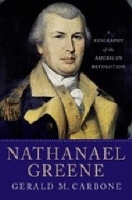Nathanael Greene – Book Review
 Nathanael Greene: A Biography of the American Revolution. Gerald M. Carbone. Palgrave/MacMillan. Hardcover: 268 pages. $27.95.
Nathanael Greene: A Biography of the American Revolution. Gerald M. Carbone. Palgrave/MacMillan. Hardcover: 268 pages. $27.95.
One of the fascinations of Greene’s life is how a Quaker forge operator from Rhode Island, … commanded key portions of the patriot army and improvised over time the tactics that culminated in victory in the South.
Newspaperman Gerald M. Carbone’s new biography of Nathanael Greene, George Washington’s indispensable general, opens with a description of the disinterment of Greene’s remains in Savannah in March 1901. The scene, full of buttons and bones, would delight an archaeologist—or a coroner.
{default}Greene had recently been re-examined in a another biography, Terry Golway’s 2005 book, Washington’s General, and both Golway and Carbone benefited from the continuing archival work on Greene’s collected papers. Carbone’s biography doesn’t bring Greene and his mind and motives to life quite as well as Golway’s. Unembellished narrative is one of Carbone’s graces, for in keeping his description of his subject straightforward—in sticking to the bones, so to speak—he allows Greene’s words and deeds to speak for themselves.
One of the fascinations of Greene’s life is how a Quaker forge operator from Rhode Island, who marched with a limp and knew war only from books, commanded key portions of the patriot army and improvised over time the tactics that culminated in victory in the South. Winning by losing and strategic retreat have long been recognized as a legacy of the revolution. Carbone shows how Greene, who struggled to arm and dress his soldiers, built on his experience as businessman and employer—his camps were well chosen and orderly—and mixed his military innovations with more conventional tactics of surprise and entrapment. Early in the war Greene erred in failing to prepare to defend Fort Washington in upper Manhattan, and he participated in some of the patriots’ worst defeats in the North. But by the time the focus of the war had shifted to the South he had had four hard years’ experience from which to learn the general’s craft, just like Washington. In the end, he bested England’s general Charles Cornwallis in key confrontations.
Nothing better illustrates the duel between Cornwallis and Greene than Greene’s deliberate attempt to induce his adversary to chase a third of Greene’s forces, led by Daniel Morgan, to the Dan River, which flows through Virginia and North Carolina. This is where Carbone’s narrative shines.
"Now that he’d lured Cornwallis into the wilds of North Carolina, Greene was determined to raise enough troops in Virginia to press an attack,” Carbone writes. “After just two days of rest, Greene sent Henry Lee’s horsemen back into North Carolina to harass the British troops as they retreated toward Hillsborough, North Carolina, to refresh; two nights after that Greene himself, protected only by a small ‘escort’ of William Washington’s cavalry, joined Lee’s legion in their secret camp. This was the equivalent of a modern-day general joining his special forces in the field."
There are two other things Carbone describes that are especially worth remembering about Greene. First, like Washington, Greene advocated burning New York City during the early urgent retreat with Washington from lower to upper Manhattan. Congress ordered them not to do it, but New York City soon after burned partially anyway, set ablaze by unknown arsonists. Second, Greene presided at the trial of British officer John Andre, who conspired with Benedict Arnold, in Tappan, N.Y., and Greene characteristically pushed on with Andre’s hanging. Greene, like others, would have preferred to hang Benedict Arnold, but Arnold was safe in New York City with the British.
Green’s political interests awakened mainly after the British Navy sought to enforce customs rules on a shipment of rum that his company was importing illegally, and Carbone makes this clear. That Greene was hardworking, disciplined and brave Carbone also makes clear. And Carbone shows that the war deprived Green of what could have otherwise been a peaceful and prosperous life. Deeply indebted for personally guaranteeing the costs of provisioning his own troops, Greene died at 43, only three years after the fighting had ended.
Not wishing to overemphasize the psychological dimension of his subject, Carbone does miss one opportunity. Greene, something of an optimist, also shared traits with Arnold, including insecurity and oversensitivity to criticism. Both endured hardship and danger. After Arnold had defected, Washington was careful to salve Greene’s feelings. Greene had chafed while doing the vital job of quartermaster, and Washington then used him briefly to replace Arnold at West Point. Finally, Washington and Congress gave Greene what he wanted most: a key command in the field.
I’m not a big fan of psycho-history, but it has its place and a more extensive comparison between Greene and Arnold—two ordinary New Englanders who rose rapidly during the war and put their stamps on the conflict—would have been an interesting read. Unfortunately, that deeper comparison is not in this work.
Carbone does successfully illuminate the vital elements of Greene’s personal and professional story, while leaving Greene for the most part on the battlefield and off the analyst’s couch.
ACG Intel

